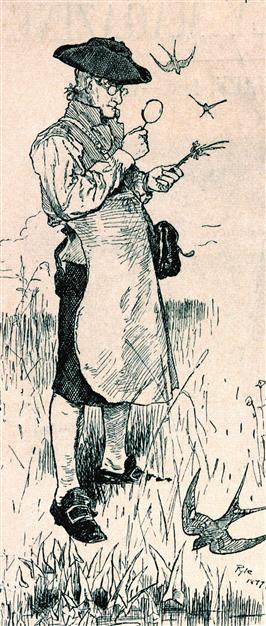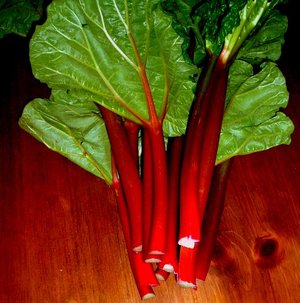The first rhubarb recipes, involving questions about historical identity.
Rhubarb is an unusual item because it is possible to identify the first manuscript as well as printed recipe entailing its use. The plant has a long transatlantic connection; it therefore is fitting to the first notation for rhubarb, describing a tart, appears in a 22 September 1739 letter from Peter Collinson in London to John Bartram in Philadelphia.
Bartram was the first person to succeed with cultivating rhubarb in North America, from seeds for two strains of the stuff that Collinson previously had sent him.  In the letter, Collinson advised his friend that both kinds of the rhubarb “make excellent tarts, before most other Fruits fitt for that purpose are ripe” and gave him a recipe:
In the letter, Collinson advised his friend that both kinds of the rhubarb “make excellent tarts, before most other Fruits fitt for that purpose are ripe” and gave him a recipe:
“All you have to do, is to take the stalks from the root, and from the leaves; peel off the rind, and cut them in two or three pieces, and put them in a crust with sugar and a little cinnamon; then bake the pie, or tart; eats best cold. It is much admired here…. It eats much like gooseberry pie.”
It is an axiom of food historians that printed recipes may lag behind kitchen practice for a considerable time, and our rhubarb tart looks like a good example. The first printed recipe does not appear until 1760, in The Compleat Confectioner; or, Housekeeper’s Guide by Hannah Glasse, who also makes an association between rhubarb and gooseberry tarts.
Glasse, like her contemporaries, and indeed like cookbook authors for a least another century, had no compunction about appropriating the recipes of others without attribution. Nonetheless it is most unlikely that she ever had seen or heard about the correspondence of Bartram and Collinson. It therefore is safe to infer that a rhubarb tart was no rarity during the decades between the letter and the book; it may a commonplace to compare the tarts, although Glasse reassures her reader that while rhubarb tarts “may be thought singular,” they “are very fine ones and have a pretty flavor.” This was no small complement to rhubarb, which only recently had been considered fit for medicinal use, not for the table, because Georgian Britons held the gooseberry in great esteem.
Glasse sends the reader who wishes to bake a rhubarb tart on a scavenger hunt through The Compleat Confectioner. Her recipe “To make Rhubarb Tarts” apparently appears at page 147 but reads:
“Take stalks of English rhubarb, that grow in the gardens, peel and cut it the size of gooseberries; sweeten it, and make them as you do gooseberry tarts.”
So to page 153 and “green Gooseberry Tarts” we turn but all we find is the general observation that
“You may either use them whole, or make a marmalade of them, with a good syrup; this last is the best method, for by this means you can easily judge how sweet they are…. ”
That is fair enough: Glasse assumed that her reader knew how to make simple syrup and would taste the marmalade to get things right while she cooked. What, however of the pastry for her tart?
At the outset of her chapter on tarts, Mrs. Glasse notes only that her reader should “make the short crust; which must be observed with all tarts intended to be eaten cold.”
Instructions for shortcrust pastry appear nowhere in the Confectioner. A recipe “To make fine Paste for Tarts,” however does, at page 53:
“Take a pound of flour, a pound of loaf sugar, beat fine, and a pund of butter, work it up all together, do not roll it, but beat it well with the rolling pin for half an hour, folding it up, and beating it out again, then roll out little pieces, as you want for your tarts.”
This is a lot of sugar so the crust will come out crisp, nearly brittle, and taste exceeding sweet to a modern palate. It also will be difficult to manipulate, for this is the shortest of crusts: It lacks water altogether.
We tend to view a tart as a tiny pie, but as we may infer from both Collinson and Mrs. Glasse the essential eighteenth century distinction lay between something to eat cold (the tart) and hot (pie). Elsewhere Glasse draws the further distinction that a tart is simpler in requiring only a single, top or bottom, crust.
Perhaps, however, they also had shrunk by 1760. Mrs. Glasse instructs her reader to “roll out little pieces” of tart pastry for the perfectly practical reason that the stuff is so dry that it is impossible to keep together at scale. But perhaps we digress.
To make a good simple rhubarb tart, follow Peter Collinson and Hannah Glasse with a little common sense. Get some little tart pans, they are cheap. Go ahead and use frozen puff pastry; the product is good and this preparation ought to be simple.
Thaw the pastry and cut to the appropriate circumference. If you choose a bottom crust you really should blind bake the pastry so do not bother; a puffy topcrust will do.
Chop some rhubarb, say half a pound, and cook it with a couple of tablespoons of water or, better, hard cider with sugar to taste. A pinch of mace with or without a little cinnamon and nutmeg adds some spark if you like. It should take less than 15 minutes for the fruit to collapse.
Preheat the oven to 425° while the filling cools, then spoon it into your pans. Top each tart with a round of pastry, crimp its edges with a fork and cut a hole in the top. You need not even brush the pastry with egg or cream, but you may.
 Your rhubarb tarts should bubble up a golden brown in about 20 minutes.
Your rhubarb tarts should bubble up a golden brown in about 20 minutes.
Note:
- For more on Bartram, Collinson, their friend Franklin and fascination with rhubarb, go to the critical.

